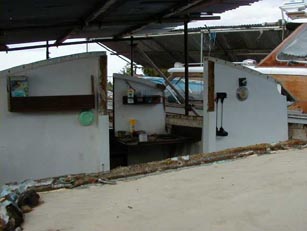

Wina II was given to me in January 1999. At the time she was afloat in Portsmouth Harbour on a deep water mooring less her mast which had obviously come to grief judging by the tangle of cut rigging evident at the time of viewing piled in the saloon.
My first step was to get her ashore, let her dry out and to have a good look at her. She came out of the water in May 99. Initial inspection revealed a very tight and sound hull. The cabin sides, port and starboard revealed rot and would need to be replaced. The cabin roof had the original canvas covering which had lifted in places and was showing signs of distress with the ingress of fresh water.
At the time of coming out of the water I had started the restoration of a Westerly 22, Sail No. 81 "Windrush" with my daughter and son-in-law. This was the first boat I had obtained and passed this on for their use.
Not wishing to restore two boats at the same time it was decided to complete "Windrush" and let "Wina II" dry out.
In September 2000 I eventually got round to starting work on "Wina II" having spent what there was of the summer sailing the Westerly and going abroad on holiday.
Not knowing what I was going to find, I took a gamble in May and ordered some Brazilian mahogany for the cabin sides, fore end and aft cockpit coaming. The cabin side and cockpit coaming being one continuous length of 18 ft x 20" x ¾".


The cabin sides were removed in one piece. Well that was the plan, the port side had to be straped with ply off cuts to stop it falling apart as they were to be used as patterns.
The extent of the restoration was beginning to look formidable. The coach roof ply skin was delaminating and would have to be replaced.
At some time in the boat's life, a ply ceiling had been fitted to the underside of the coach roof deck beams and the void filled with loft insulation fibre. Without air circulation the beams were suffering from dry rot in the centre of the deck and wet rot at the ends.
The rot had transferred to the beam shelf on both sides of the cabin. They would also have to be replaced. By carefully dismantling the beams and shelves, I had patterns for the replacements.

Next to come off were the side decks of ⅜ marine ply. Some time in the past the canvas had been removed and the deck fibre glassed. It had not bonded to the deck or to the sheer strake and it had not prevented the ingress of water to the ply which was in a very bad state. Rot had transferred to the deck shelf and the mahogany sheer strake both of which would have to be replaced on each side of the boat.
Rot also revealed itself in the outer edges of the ½" ply aft cabin bulkheads something will have to be done about that.
In short, everything from the deck up, including the sheer strakes will have to be replaced. As yet, the fore and after decks have not been lifted and will not be done until the skeleton of the cabin is replaced and also the roof beams to tie the hull back together midships. I would like to replace the aft bulkhead but as it is tying the hull together I am reluctant to take it out for fear of losing the datums. I can't take it out when the cabin sides and cockpit coaming go back in - Catch 22.
I seem to have 2 options:
1. Cut the rot back to good wood and insert a rebated post of mahogany and profile it to contour.
2. Re-skin the outside having first cut back the rot. Insert a profiled piece of ply to replace the piece cut out, glued and butted to the cut and cover the join in the cabin with a bit of mahogany trim.
Two deck shelves have been machined and cut feather edged from 4"x2"x18ft length of Douglas fir. They have been primed and are ready to go back in when the old primer has been removed from the stringer and frames and re-primed.
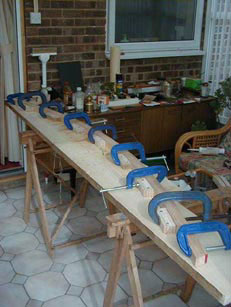
A jig has been manufactured on which to laminate the coach roof deck beams. Four laths make up a beam 1 ¼ x 1 ⅜ deep x 7ft long having a total camber of 9". The timber is Douglas fir bonded with cascaphen. Because the curvature and the bond are quite highly stressed I leave them cramped to the jig for 48 hrs. 12 beams are required.
The cabin deck beam shelves have also been manufactured. These are Douglas fir 1"x2"x10ft chamfered on one edge to suit the camber of the deck. Having machined them I noticed too late that the originals had been laminated to the curve of the cabin sides. They have been cramped to the originals and will be left like that until required in the hope that some of the stress will dissipate. They will eventually be glued and screwed to the cabin sides.
During the process of cutting back the after bulkhead prior to inserting posts and reskinning both sides, a small area of rot was discovered in the starboard deep frame which the bulkhead was through bolted to. Fortunately it was not too serious and I was able to cut the rot in situe and scarf a new piece back in.
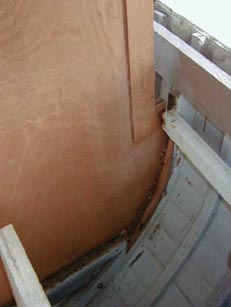
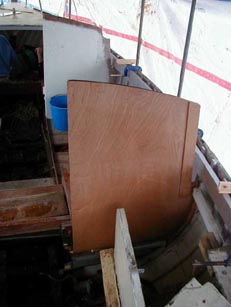
To date, the aft bulkhead has been completely restored and new deck shelves have been fitted to both port and starboard sides.
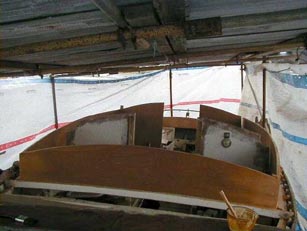
The cabin sides, cockpit coaming and cabin front are now fitted and the screw holes plugged and sanded down. Although cut from the original patterns, they did not go back the same. Possibly the feather edge of the new deck shelf was slightly out. It has not caused any major problem. Although it would have been easier to cut the window apertures before fitting the sides, I was worried that because of the curvature in the 18ft length there was a grave risk of the sides splitting. They will be cut when the roof beam shelves and beams have been fitted.
Having previously machined and pre-drilled the shelves, I was disappointed that I could not spring them in. Because the edge adjacent to the cabin side is angled to match the roof camber the G cramps kept sliding off. To overcome the problem they would have to be laminated. They were pushed though the saw and cut in two and ¼" lath inserted to compensate for the saw blade width. They have been glued up and clamped to the originals to cure.
Now that the cabin sides are back in place and the boat stiffened up, the foredeck and afterdeck have been taken up. On the aft deck the beams are sound but require re-fixing. The foredeck revealed rot to the breast hook and the first two deck beams. There is evidence of a small amount of rot on the port side of the stemhead. When the sheer planks are removed the rot will be cut out and a new piece laminated in.
A new breast hook and beams have been manufactured ready for fitting.
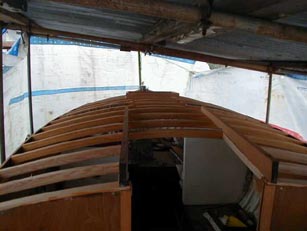
The cabin deck beam shelves have been fitted. Laminating them proved very successful and they went in easily. They were screwed and glued with West epoxy and the holes plugged and sanded flush.
The beams have been cut to length and fitted at their respective stations and carlins made and fitted to take the half beams at the fore hatch and aft hatchway. These were screwed and glued in place.
The weather in December had been rather inclement with persistent heavy rain and very strong winds and although the boat is covered it had been very trying working on it. The time was not wasted. At home, new cabin top grab rails, foredeck toe rails and fore hatch coaming were manufactured in mahogany. The forehatch cover is in the process of being restored, although sound, was very tatty. The deck will be re-skinned with rebated mahogany strip and caulked with arborcol boat caulk and re-varnished. The main hatch will be similarly treated.
I had plans to do a lot of work to the boat over Christmas and ended up doing nothing until mid January 2001 having caught a virus infection which was doing its winter rounds. Apart from the illness it was probably just as well as the daytime temperature seldom got above 4°C. I don't like the cold. The time was spent on the drawing board drawing up the mast support ring beam and support pads, redesigning the windows and spectacle frames and routing templates for the rebated windows. The windows now have full radiused ends to eliminate the corner stresses of square cornered windows as originally made.
The ring beam has been made and fitted as has the underside mast support pad which is let into three of the coach roof beams to spread the load.


A router jig has been made from 6mm ply for the cabin windows and they have been cut and rebated.